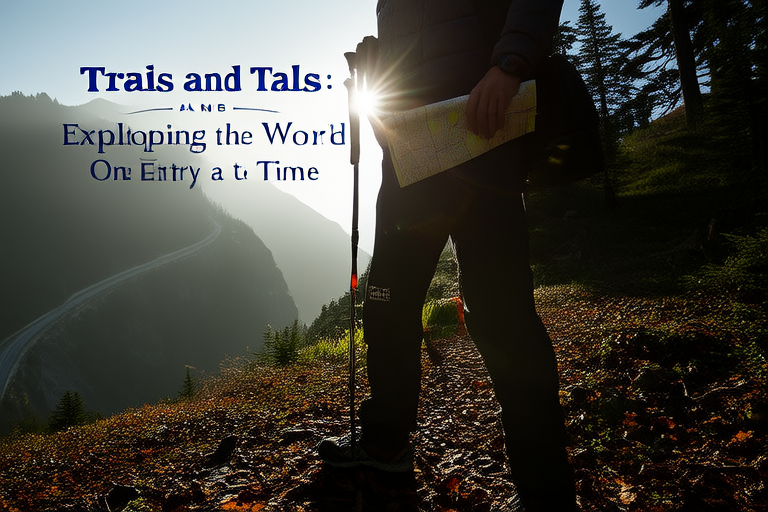Trails and Tales: Exploring the World One Entry at a Time

Trails and Tales: Exploring the World One Entry at a Time
Introduction
The world is vast, filled with countless wonders waiting to be discovered. From towering mountains to serene beaches, from bustling cities to remote villages, each corner of the globe holds its own unique story. But it’s not just the places themselves that captivate us; it’s the journey we take to reach them, the trails we follow, and the tales we carry back home. Whether literal or metaphorical, trails play a crucial role in shaping our understanding of different cultures and landscapes. Each journey, no matter how small, contributes to a larger narrative of discovery and self-discovery.
In this article, we will explore the magic of trails, share tales from the road, delve into the art of storytelling, and discuss the importance of sustainable travel. By the end, you’ll be inspired to embark on your own adventures, one trail at a time.
The Magic of Trails
Trails come in many forms—hiking paths, historical routes, cultural trails, and more. Each type offers a unique perspective on the world around us. For example, the Inca Trail in Peru winds through the Andes Mountains, offering breathtaking views of ancient ruins and lush greenery. The Appalachian Trail stretches across the eastern United States, providing hikers with a challenging yet rewarding experience. And the Silk Road, an ancient network of trade routes connecting Asia and Europe, carries with it centuries of history and cultural exchange.
These trails connect people across time and space, offering insights into history, nature, and human resilience. They remind us that we are all part of a larger narrative, sharing common threads of adventure, curiosity, and perseverance.
Tales from the Road
Every traveler has a story to tell. Whether it’s a harrowing hike up a mountain or a serendipitous encounter with a local community, these tales enrich our understanding of the world. Let’s hear from a few intrepid adventurers:
One traveler recounts their journey along the Camino de Santiago in Spain. What began as a solo pilgrimage turned into a shared experience with fellow pilgrims from all corners of the globe. Along the way, they faced physical exhaustion, emotional highs and lows, and moments of profound reflection. This journey not only tested their physical limits but also deepened their spiritual connection to the land.
Another traveler shares their experience trekking through the Himalayas. The challenges were immense—high altitudes, unpredictable weather, and rugged terrain. But the rewards were equally great. They discovered hidden valleys, encountered rare wildlife, and formed lasting bonds with the local Sherpa community. These experiences left a lasting impression on their life, reminding them of the beauty and resilience of nature.
Through these stories, we gain a broader understanding of the world, its people, and its landscapes. Each tale adds a new layer to the rich tapestry of human experience.
The Art of Storytelling
Storytelling plays a vital role in travel writing and photography. Writers and photographers have the unique ability to capture the essence of a place through words and images, transporting readers and viewers to distant lands. Notable travel writers like Pico Iyer and Paul Theroux have inspired countless adventurers with their vivid descriptions and insightful observations. Similarly, photographers like Steve McCurry and David Alan Harvey have captured the beauty and complexity of the world through their lenses.
The art of storytelling lies in conveying the emotions, sights, and sounds of a place in a way that resonates with others. It’s about finding the universal in the specific, the timeless in the fleeting moment. Through their work, these creators invite us to see the world through their eyes, encouraging us to explore new destinations and embrace the spirit of adventure.
Sustainable Travel and Preservation
As we explore the world, it’s essential to consider the impact of our travels on the environment and local communities. Responsible travel and preservation are key to ensuring that future generations can enjoy the same wonders we do today.
Eco-friendly travel practices include minimizing waste, supporting local businesses, and respecting local customs. Simple actions like carrying a reusable water bottle, staying on marked trails, and avoiding single-use plastics can make a significant difference. Additionally, supporting local communities by purchasing locally-made goods and dining at family-owned restaurants helps boost the local economy.
There are numerous initiatives and organizations working towards sustainable tourism. For example, the United Nations World Tourism Organization promotes sustainable tourism development worldwide, while organizations like the Rainforest Alliance work to protect ecosystems and promote responsible travel practices.
Conclusion
In conclusion, trails and tales are integral to our understanding of the world. Whether through hiking paths, historical routes, or cultural trails, each journey contributes to a larger narrative of discovery and self-discovery. Personal stories from travelers provide valuable insights into different cultures and landscapes, while the art of storytelling captures the essence of these experiences.
We encourage you to embrace the spirit of exploration and storytelling, one trail at a time. Share your own travel tales and inspire others to embark on similar journeys. Together, we can create a richer, more connected world, one step at a time.